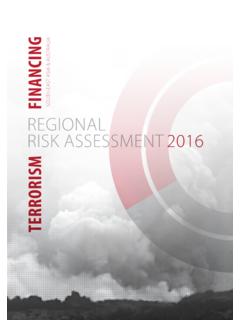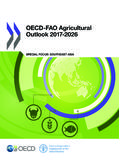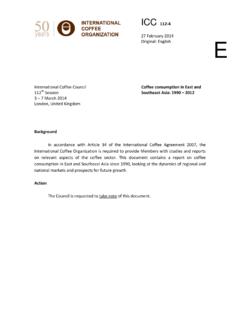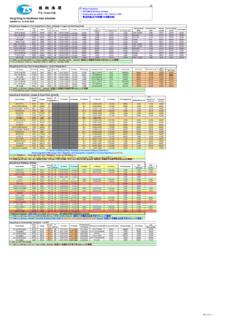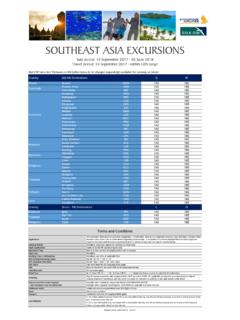Transcription of www.oecd.org/site/seao
1 POCKET EDITION. Economic Outlook for southeast asia , China and India 2014 Economic Outlook for BEYOND THE MIDDLE-INCOME TRAP southeast asia , China and India The Economic Outlook for southeast asia , China and India 2014: Beyond the Middle-income Trap presents a medium-term (five year) economic outlook for Emerging asia , a specific 2014. focus on the middle-income trap and an assessment of national structural policy reforms and BEYOND THE MIDDLE-INCOME TRAP. medium-term development plans. The report highlights the fact that economies in the region will remain resilient in the next five years, supported by the growing strength of domestic demand.
2 It also calls for greater efforts in the push for further economic integration in ASEAN, in particular in the areas of human capital development and poverty. Contents Chapter 1. Medium-term economic outlook for Emerging asia : Prospects and assessments Chapter 2. Structural policy country notes for Emerging asia Chapter 3. Policy priorities for growing beyond the middle-income trap in Emerging asia Economic Outlook for southeast asia , China and India 2014. Beyond the Middle-Income Trap The full report is available on line at: The full report is published on the OECD iLibrary, , which gathers all OECD books, periodicals and statistical databases.
3 Further information on southeast asia , China and India is available on: Contact us: Economic Outlook for southeast asia , China and India 2014 OECD 2013. Medium-term economic outlook: Prospects and assessments The economic outlook in Emerging asia ( southeast asia , China and India) remains robust over the medium term, anchored by the steady rise in domestic demand. Real GDP growth in Emerging Asian economies is projected to be moderating gradually but remains robust over the 2014-18 period, according to the results of the OECD Development Centre's Medium-Term Projection Framework (MPF-2014).
4 For this 2014 edition of the Economic Outlook for southeast asia , China and India. As a whole, the Emerging Asian economies are expected to grow by per annum in 2014-18. It is a robust pace, albeit less than the registered before the global financial crisis (2000-07). This slower rate of growth largely reflects the moderate rates of expansion in the two large Emerging Asian economies of China and India. In the southeast Asian region, growth will remain robust in the medium term, growing at a pace which is comparable to the pre-global financial crisis. The real GDP growth rate in the southeast Asian region is projected to average per annum between 2014-18, against in 2000-07 (Table ).
5 Table Real GDP growth of southeast asia , China and India (annual percentage change). 2012 2018 2014-18 2000-07. ASEAN-6 countries Brunei Darussalam - Indonesia Malaysia Philippines Singapore Thailand CLMV countries Cambodia Lao PDR Myanmar - - Viet Nam Average of ASEAN 10 (*) (**). 2 large economies in Emerging asia China India Average of Emerging asia Notes: The cut-off date for data is 6 September 2013. Emerging asia includes ASEAN 10 countries plus China and India. * Excluding Myanmar, ** Excluding Brunei Darussalam and Myanmar. Source: OECD Development Centre, MPF-2014. For more detailed information on MPF, see 2 Economic Outlook for southeast asia , China and India 2014 OECD 2013.
6 The GDP growth projections for individual countries reflect their different stages of development and medium-term growth drivers. Indonesia is projected to be the fastest-growing economy within the ASEAN-6, with an average annual growth rate of in 2014-18, followed by the Philippines with These projected medium-term growth rates are considerably higher than the average growth prior to the global financial crisis ( and respectively). The strong medium-term economic outlook for Indonesia and the Philippines will be underpinned by robust growth in domestic demand, strong infrastructure spending and implementation of structural economic reforms.
7 Led by rising growth in domestic demand, especially in infrastructure investment and private consumption, real GDP in Malaysia and Thailand is projected to grow by an average annual rate of and , respectively, over the period 2014-18. While their projected growth rates compare favourably to those of other developing countries at similar stages of economic development, both Malaysia and Thailand should improve their productivity in order to grow beyond the middle-income trap. Singapore's economy is projected to grow by per annum over the period 2014-18. The rate of growth reflects the country's more advanced stage of economic development as its economy shifts towards more sustainable, inclusive growth led by rising productivity and innovation.
8 The CLMV countries (Cambodia, Lao PDR, Myanmar and Viet Nam) are projected to grow at a robust pace over the medium term, led by Lao PDR at per annum. Real GDP growth in Cambodia and Myanmar is projected to average close to 7%. between 2014-18, underscoring the significant improvement in these countries'. investment appeal as they open up to foreign investment. As for Viet Nam, while its real GDP is projected to remain robust in the medium term, growth will be slower than prior to the global financial crisis because of slower external demand from advanced economies and weak macroeconomic management policies which could jeopardise growth.
9 China's real GDP growth is expected to moderate to around in 2014-18 (compared to during 2000 and 2007), as the country rebalances its growth model towards growth driven by domestic consumption. Implementation of structural reforms will also be a critical factor in driving the Chinese economy towards sustainable development and growing beyond the middle-income trap. The slowdown in China, in particular, could weaken the growth momentum of southeast Asian economies, as they become more dependent on China as a key trading partner. At the same time, India's growth is expected to moderate to (2014-18), compared to between 2000-07.
10 Economic Outlook for southeast asia , China and India 2014 OECD 2013 3. The other main results of MPF-2014 are as follows: Over the medium term, growth in private consumption and investment will continue to be robust, providing a key anchor for domestic demand and making an important contribution to overall GDP growth in many countries in Emerging asia . Most ASEAN-6 countries will remain in current account surplus, while CLMV countries will remain in deficit in the medium term. Fiscal deficits will narrow in most countries, leading to stable or lower public debt-to-GDP ratios that are lower or stable.










